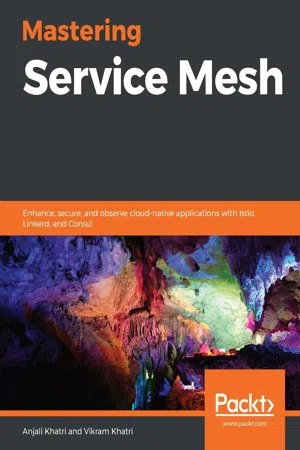
Mastering Service Mesh
Enhance, secure, and observe cloud-native applications with Istio, Linkerd, and Consul
- 626 pages
- English
- ePUB (mobile friendly)
- Available on iOS & Android
Mastering Service Mesh
Enhance, secure, and observe cloud-native applications with Istio, Linkerd, and Consul
About this book
Understand how to use service mesh architecture to efficiently manage and safeguard microservices-based applications with the help of examples
Key Features
- Manage your cloud-native applications easily using service mesh architecture
- Learn about Istio, Linkerd, and Consul – the three primary open source service mesh providers
- Explore tips, techniques, and best practices for building secure, high-performance microservices
Book Description
Although microservices-based applications support DevOps and continuous delivery, they can also add to the complexity of testing and observability. The implementation of a service mesh architecture, however, allows you to secure, manage, and scale your microservices more efficiently. With the help of practical examples, this book demonstrates how to install, configure, and deploy an efficient service mesh for microservices in a Kubernetes environment.
You'll get started with a hands-on introduction to the concepts of cloud-native application management and service mesh architecture, before learning how to build your own Kubernetes environment. While exploring later chapters, you'll get to grips with the three major service mesh providers: Istio, Linkerd, and Consul. You'll be able to identify their specific functionalities, from traffic management, security, and certificate authority through to sidecar injections and observability.
By the end of this book, you will have developed the skills you need to effectively manage modern microservices-based applications.
What you will learn
- Compare the functionalities of Istio, Linkerd, and Consul
- Become well-versed with service mesh control and data plane concepts
- Understand service mesh architecture with the help of hands-on examples
- Work through hands-on exercises in traffic management, security, policy, and observability
- Set up secure communication for microservices using a service mesh
- Explore service mesh features such as traffic management, service discovery, and resiliency
Who this book is for
This book is for solution architects and network administrators, as well as DevOps and site reliability engineers who are new to the cloud-native framework. You will also find this book useful if you're looking to build a career in DevOps, particularly in operations. Working knowledge of Kubernetes and building microservices that are cloud-native is necessary to get the most out of this book.
Frequently asked questions
- Essential is ideal for learners and professionals who enjoy exploring a wide range of subjects. Access the Essential Library with 800,000+ trusted titles and best-sellers across business, personal growth, and the humanities. Includes unlimited reading time and Standard Read Aloud voice.
- Complete: Perfect for advanced learners and researchers needing full, unrestricted access. Unlock 1.4M+ books across hundreds of subjects, including academic and specialized titles. The Complete Plan also includes advanced features like Premium Read Aloud and Research Assistant.
Please note we cannot support devices running on iOS 13 and Android 7 or earlier. Learn more about using the app.
Information
Section 1: Cloud-Native Application Management
- Chapter 1, Monolithic Versus Microservices
- Chapter 2, Cloud-Native Applications
Monolithic Versus Microservices
- Early computer machines
- Monolithic applications
- Microservices applications
Early computer machines
Hardware virtualization
Software virtualization
Container orchestration
Table of contents
- Title Page
- Copyright and Credits
- About Packt
- Foreword
- Contributors
- Preface
- Section 1: Cloud-Native Application Management
- Monolithic Versus Microservices
- Cloud-Native Applications
- Section 2: Architecture
- Service Mesh Architecture
- Service Mesh Providers
- Service Mesh Interface and SPIFFE
- Section 3: Building a Kubernetes Environment
- Building Your Own Kubernetes Environment
- Section 4: Learning about Istio through Examples
- Understanding the Istio Service Mesh
- Installing a Demo Application
- Installing Istio
- Exploring Istio Traffic Management Capabilities
- Exploring Istio Security Features
- Enabling Istio Policy Controls
- Exploring Istio Telemetry Features
- Section 5: Learning about Linkerd through Examples
- Understanding the Linkerd Service Mesh
- Installing Linkerd
- Exploring the Reliability Features of Linkerd
- Exploring the Security Features of Linkerd
- Exploring the Observability Features of Linkerd
- Section 6: Learning about Consul through Examples
- Understanding the Consul Service Mesh
- Installing Consul
- Exploring the Service Discovery Features of Consul
- Exploring Traffic Management in Consul
- Assessment
- Other Books You May Enjoy